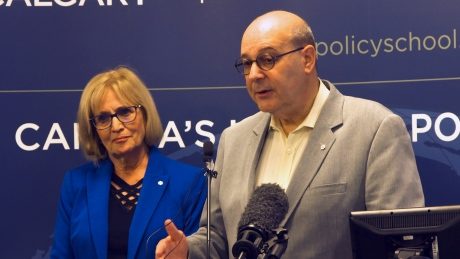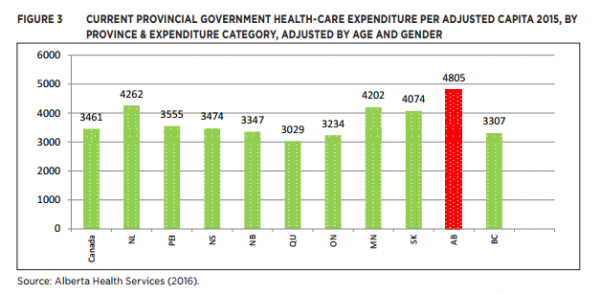‘Lower forever’ oil prices mean Alberta needs to quickly rein in budget deficits – Part 1
MacKinnon/Mintz prescription for balanced budget: constrain public sector wages, reduce healthcare costs, lower business taxes
Sooner or later, an Alberta government will have to grapple with the effect of “lower forever” oil prices – to quote Shell CEO Ben van Beurden – on the province’s treasury. A new report from the School of Public Policy suggests there is good news (plenty of fiscal capacity because of Alberta’s low debt) and bad news (tough choices ahead) for the premier who departs from the usual practice of waiting out oil and gas busts until the next boom comes along.
“Putting the Alberta Budget on a New Trajectory” is authored by tax specialist Jack Mintz and Janice MacKinnon, a former finance minister during the 1990s under the Saskatchewan NDP government of Roy Romanow. Full disclosure: I was a graduate school teaching assistant under McKinnon from 1984 to 1986.
The study starts by acknowledging that the budget choices made by Premier Rachel Notley’s NDP government are entirely consistent with previous Alberta governments, which presumably means those of the Progressive Conservatives who came to power in 1971. It also acknowledges that the NDP were elected in 2015 just after the collapse of global oil prices in late 2014.
“The circumstances were obviously very challenging and running deficits was understandable and unavoidable,” the study says.
But its central thesis is that this time is different and Notley and finance minister Joe Ceci must correct course if the public purse is going to avoid running structural deficits.
“The NDP’s spending choices appear to be based on the precarious assumption that a rebound in oil prices will heal what ails the Alberta economy, as well as on the refusal to significantly reduce spending with almost zero attempt to contain costs,” Mintz said in the press release accompanying the study.
“The NDP bases its choices on a black-and-white scenario of either spending or imposing austerity and drastic cutbacks. However, there is a middle ground that would allow the government to maintain services without the quality of those services suffering.”
Alberta’s 2017 budget projects deficits of $10.3 billion this fiscal year, dropping to $7.2 billion by 2019-2020, according to the release, with a return to balance in 2023/24. Moody’s, the influential credit rating agency, downgraded the Alberta creditworthiness in August, noting that while the government was in good shape relative to other provinces, with plenty of room for more debt and “fiscal flexibility to enact spending and tax measures,” it was still exposed to volatile oil prices.
What will oil prices do between now and the mid-2020s?
Those of an optimistic mind can argue that the $400 billion cut from global exploration and production during 2015 and 2016 will eventually lead to a supply shortage, which coupled with growing demand will cause prices to spike, perhaps even rise above $100 again.
More pessimistic observers point to American shale production, the industry game changer that can rapidly bring on new oil supply when prices rise, thus serving as a continual brake on price increases.
The International Energy Agency’s recently released World Energy Energy Outlook 2017 contains a low oil price case that sets out the conditions for $50 to $70 a barrel all the way to 2040: “high resource assumption for US tight oil; widespread up-take of digital and other technologies that help keep a lid on upstream costs; exceptionally rapid growth in the electric car fleet; and a favourable assumption about the ability of the main resource owners to weather the storm of lower revenues.”
The Alberta oil industry is planning for a “lower forever” future, why isn’t the government?
I interviewed MacKinnon about the prescription for that middle ground. The interview has been lightly edited for clarity.
Markham: Why don’t we start with an overview of the study?
MacKinnon: I think there were two reasons why we wanted to do it. First of all, to actually look at Alberta’s fiscal situation. What is the situation? If you look at the budget, it’s built on very optimistic assumptions about the price of oil. The fiscal situation is bad, but it could be worse.
Probably more importantly, we wanted to look at, what can you do about the situation?
What sort of steps can the government take in the short-term to actually bridge the yawning gap between spending and revenue.
Ironically, the good news is that compared to BC, Ontario, and Quebec, Alberta’s a really big spender. If you look at ways in which these provinces have controlled spending or increased revenue, you could actually begin to address the deficit problem and the debt problem without actually reducing programs or making drastic cuts.
We looked at the issue of public sector bargaining. Salaries in Alberta for the public sector much higher than other provinces. If you look at what happened in Manitoba and Nova Scotia, they established a public sector bargaining mandate in which you say, “For these years, this is what the salary levels are going to be? Zero, zero, or whatever. And you can impose it as long as you respect the public sector bargaining process.
We looked at infrastructure. One of the problems with infrastructure is the Dodge report looked at, “Well, what should Alberta spend relative to GDP?” Well, in Alberta, a couple of years ago, that would be very high. But now, of course, it would be really low.
So what we did there is we asked, “Okay, what about infrastructure relative to need and population?” And again, if you looked 2010-15, Alberta spent significantly more on infrastructure, all of the levels of government than the other provinces, the infrastructure isn’t as old. You could save money by bringing the infrastructure in Alberta down to the average of the other provinces.
I think in terms of dollars, the really big one, and we checked these numbers like three or four times because it was hard to believe, if you look at the spending per capita in Alberta relative to the other provinces and if you take Alberta spending just halfway to where the other big provinces are, not all the way, you can save over time $6.6 billion [a year].
So we looked at that and then we looked at health and how Alberta’s health system is more expensive than Ontario and BC, the outcomes aren’t as good, the changes that Ontario and BC made to control costs that get better results.
Then finally we looked at growing the economy. The tax mix can be changed to move to taxes that promote growth instead of curtailing growth. If you look at Saskatchewan in the 1990s, one of the difficult things the government had to do is say, “Look, we’re going to have to lower taxes on business and high-income people. We’re going to have to reduce red tape to actually get investment,” whereas here, it’s going the opposite way. Increased taxes on high-income people and big business and increase of minimum wage. More carbon levies, etc. And that really gives a negative message to business.












Lower business taxes! Business is nowhwhere near paying its fair share and then there are the Bombadier subsidies. 85 % of the federal budget is paid for by individuals. No more free riders.